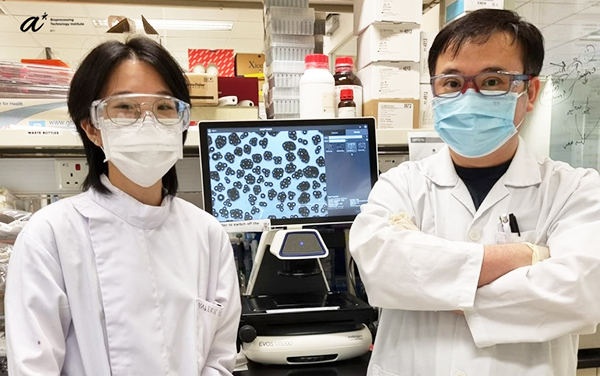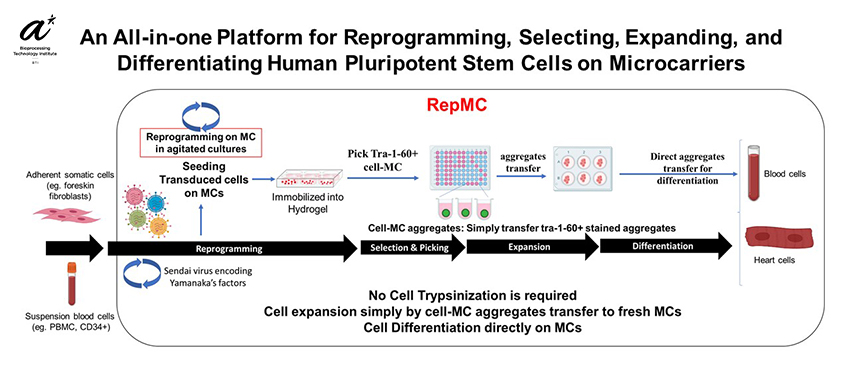Reprogramming Pluripotent Cells on Beads is 50-Fold Better
Science
Cellular reprogramming is the act of reverting mature, specialised cells into induced pluripotent stem cells (iPSCs). iPSCs and their differentiated derivatives have a remarkable potential to be used for regenerative medicine. They hold great promise as therapeutic products such as for blood transfusions, heart repair and treatment for Parkinson’s disease. However, one of the greatest challenges is the robust production of these cells at a quantity needed to meet therapeutic demand. To address these challenges, our team has developed an all-in-one platform for reprogramming, selecting, expanding, and differentiating human pluripotent stem cells called RepMC (Reprogramming on Microcarriers). This method speeds up cellular reprogramming, and also allows for faster selection and expansion of high-quality candidates/iPSCs for differentiation into specialised cells such as heart and blood cells).
Societal Impact
Reprogramming somatic cells to iPSCs via the conventional monolayer culture is plagued by low efficiencies, high levels of manipulation and operator unpredictability. This leads to a “bioprocess gap” between selecting large numbers of high-quality iPSC and their potential clinical applications. The RepMC (Reprogramming on Microcarriers) accelerates reprogramming by 7 days and providing between 30 to 50-fold more clones to choose from. This method was tested for a wide range of cell sources: fibroblasts, peripheral blood mononuclear cells, T cells and CD34+ blood stem cells. RepMC is also a robust platform as it has the ability to expand and efficiently differentiate to the three germ-layers, heart cells and blood. The platform is also amenable to automation, allowing for robotic processes to replace manual handling.
Technical Summary
We developed a microcarrier (MC) reprogramming platform for iPSCs derivation, isolation, propagation, and differentiation (RepMC), under feeder-free conditions. Human somatic cells in suspension were transduced with Sendai virus encoding Oct4, Sox2, Klf4, and c-Myc. The suspension cells were then seeded on Laminin (LN)-coated MCs for further selection. Six days later cell covered-MC (cell-MC) were immobilized into a hydrogel and stained with Tra-1-60 to select for iPSC-like cells. Tra-1-60+ cell-MCs were then progressively scaled up from 96-well plates to 12- and 6-well plates over 4 weeks by the addition of more LN-coated MCs into the wells without detaching cells by trypsinization, demonstrating the ease of using an MC platform. The selected cell-MC aggregates were further differentiated to cardiomyocytes and erythroblasts directly without trypsinization.
Time-course gene analysis of MC reprogramming reveals that agitation helps to increase reprogramming efficiencies through the modulation of chromatin structure and signalling pathways during the initiation phase and mid phase of reprogramming. Induction of genes (β-catenin, E-cadherin and EpCAM) occurred earlier in MC cultures, on Day 4, instead of in monolayer cultures, which typically occur on Days 14 or later. Higher expression of β-catenin could activate the Wnt/β-catenin pathway which is necessary during the initiation phase of reprogramming. Following that, faster induction, and earlier stabilization of pluripotency genes (Nanog, Lin28A, Sall4, Oct4, Sox2 and Klf4) occurred during the maturation phase of reprogramming (after day 7) in the RepMC vs. monolayer method (after days 12-14). Integrated expansion and efficient differentiation to the three germ layers as well as to the cardiomyocyte and blood lineages was further demonstrated by the RepMC. In summary, we have developed a novel MC-based reprogramming method which allows for high throughput and reprogramming efficiencies (30-50-fold as compared to the monolayer method) with possibility for automation, enabling the industrialisation of reprogramming.
References
Alan Tin Lun Lam, Valerie Ho, Svetlan Vassilev, Shaul Reuveny, Steve Kah Weng Oh. An allied reprogramming, selection, expansion and differentiation platform for creating hiPSC on microcarriers. Cell Proliferation. 19 May 2022. doi.org/10.1111/cpr.13256.
A*STAR celebrates International Women's Day

From groundbreaking discoveries to cutting-edge research, our researchers are empowering the next generation of female science, technology, engineering and mathematics (STEM) leaders.
Get inspired by our #WomeninSTEM
.png?sfvrsn=1a7df424_3)

